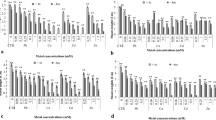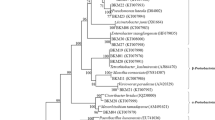Abstract
In the salt marshes of the joint estuary of Tinto and Odiel rivers (SW Spain), one of the most polluted areas by heavy metals in the world, Spartina densiflora grows on sediments with high concentrations of heavy metals. Furthermore, this species has shown to be useful for phytoremediation. The total bacterial population of the rhizosphere of S. densiflora grown in two estuaries with different levels of metal contamination was analyzed by PCR denaturing gradient gel electrophoresis. Results suggested that soil contamination influences bacterial population in a greater extent than the presence of the plant. Twenty-two different cultivable bacterial strains were isolated from the rhizosphere of S. densiflora grown in the Tinto river estuary. Seventy percent of the strains showed one or more plant growth-promoting (PGP) properties, including phosphate solubilization and siderophores or indolacetic acid production, besides a high resistance towards Cu. A bacterial consortium with PGP properties and very high multiresistance to heavy metals, composed by Aeromonas aquariorum SDT13, Pseudomonas composti SDT3, and Bacillus sp. SDT14, was selected for further experiments. This consortium was able to two-fold increase seed germination and to protect seeds against fungal contamination, suggesting that it could facilitate the establishment of the plant in polluted estuaries.


Similar content being viewed by others
References
Abou-Shanab RAI, van Berkum P, Angle JS (2007) Heavy metal resistance and genotypic analysis of metal resistance genes in Gram-positive and Gram-negative bacteria present in Ni-rich serpentine soil and in the rhizosphere of Alyssum murale. Chemosphere 68:360–367. doi:10.1016/j.chemosphere.2006.12.051
Ahemad M, Khan MS (2011) Functional aspects of plant growth promoting rhizobacteria: recent advancements. Insight Microbiol 1:39–54. doi:10.5567/IMICRO-IK.2011.39.54
Alexander DB, Zureber DA (1991) Use of Chrome azurol S reagents to evaluate siderophore production by rhizosphere bacteria. Biol Fertil Soils 12:39–45. http://link.springer.com/article/10.1007/BF00369386
Bhattacharyya PN, Jha DK (2012) Plant growth-promoting rhizobacteria (PGPR): emergence in agriculture. World J Microbiol Biotechnol 28:1327–1350. doi:10.1007/s11274-011-0979-9
Bric JM, Bostock RM, Silverstone SE (1991) Rapid in situ assay for indole acetic acid production by bacteria immobilized on nitrocellulose membrane. Appl Environ Microbiol 57:535–538. http://aem.asm.org/content/57/2/535.full.pdf+html
Burd G, Dixon DG, Glick B (2000) Plant growth-promoting bacteria that decreases heavy metal toxicity in plants. Can J Microbiol 46:237–245. doi:10.1139/w99-143
Cambrollé J, Redondo-Gómez S, Mateos-Naranjo E, Figueroa ME (2008) Comparison of the role of two Spartina species in terms of phytostabilization and bioaccumulation of metals in the estuarine sediment. Mar Pollut Bull 56:2037–2042. doi:10.1016/j.marpolbul.2008.08.008
Cambrollé J, Mateos-Naranjo E, Redondo-Gómez S, Luque T, Figueroa ME (2011) The role of two Spartina species in phytostabilization and bioaccumulation of Co, Cr, and Ni in the Tinto–Odiel estuary (SW Spain). Hydrobiologia 671:95–103. doi:10.1007/s10750-011-0706-4
Carrasco JA, Armario P, Pajuelo E, Burgos A, Caviedes MA, López R, Chamber MA, Palomares AJ (2005) Isolation and characterisation of symbiotically effective Rhizobium resistant to arsenic and heavy metals after the toxic spill at the Aznalcóllar pyrite mine. Soil Biol Biochem 37:1131–1140. doi: doi: 10.1016/j.soilbio.2004.11.015
Chun J, Lee J-H, Jung Y, Kim M, Kim S, Kim BK, Lim YW (2007) EzTaxon: a web-based tool for the identification of prokaryotes based on 16S ribosomal RNA gene sequences. Int J Syst Evol Microbiol 57:2259–2261. doi:10.1099/ijs.0.64915-0
Dary M, Chamber-Pérez MA, Palomares AJ, Pajuelo E (2010) “In situ” phytostabilisation of heavy metal polluted soils using Lupinus luteus inoculated with metal resistant plant-growth promoting rhizobacteria. J Haz Mat.177:323–330. doi: 10.1016/j.jhazmat.2009.12.035
Davis DA, Gamble MD, Bagwell CE, Bergholz PW, Lovell CR (2011) Responses of salt marsh plant rhizosphere diazotroph assemblages to changes in marsh elevation, edaphic conditions and plant host species. Microb Ecol 61:386–398. doi:10.1007/s00248-010-9757-8
El Aafi N, Brhada F, Dary M, Maltouf AF, Pajuelo E (2012) Rhizostabilization of metals in soils using Lupinus luteus inoculated with the metal resistant rhizobacterium Serratia sp. MSMC54. Int J Phytorem 14:261–274. doi:10.1080/15226514.2011.604693
Fickers P (2012) Antibiotic compounds from Bacillus: why are they so amazing? Am J Biochem Biotech 8:40–46. doi:10.3844/ajbbsp.2012.40.46
Fromin N, Hamelin J, Tarnawski S, Roesti D, Jourdain-Miserez K, Forestier N, Teyssier-Cuvelle S, Gillet F, Aragno M, Rossi P (2002) Statistical analysis of denaturing gel electrophoresis (DGE) fingerprinting patterns. Environ Microbiol 4:634–643. doi:10.1046/j.1462-2920.2002.00358.x
Gamble MD, Bagwell CE, LaRocque J, Bergholz PW, Lovell CR (2010) Seasonal variability of diazotroph assemblages associated with the rhizosphere of the salt marsh cordgrass, Spartina alterniflora. Microb Ecol 59:253–265. doi:10.1007/s00248-009-9558-0
Glick BR (2010) Using soil bacteria to facilitate phytoremediation. Biotechnol Adv 28:367–374. doi:10.1016/j.biotechadv.2010.02.001
Grčman H, Velikonja-Bolta S, Vodnik D, Kos B, Leštan D (2001) EDTA enhanced heavy metal phytoextraction: metal accumulation, leaching, and toxicity. Plant Soil 235:105–114. doi:10.1023/A:1011857303823
Heuer H, Krsek M, Baker P, Smalla K, Wellington EMH (1997) Analysis of Actinomycetes communities by specific amplification of genes encoding 16S rRNA and gel-electrophoretic separation in denaturing gradients. Appl Environ Microbiol 63:3233–3241
Khan MS, Zaidi A, Wani PA (2006) Role of phosphate-solubilizing microorganisms in sustainable agriculture—a review. Agron Sustainable Dev 27:29–43. doi:10.1051/agro:2006011
Kuiper I, Lagendijk EL, Bloemberg GV, Lugtenberg TJJ (2004) Rhizoremediation: a beneficial plant-microbe interaction. Mol Plant Microb Interact 17:6–15. doi:10.1094/MPMI.2004.17.1.6
Loper JE, Schroth MN (1986) Influence of bacterial sources of indole-3-acetic acid on root elongation of sugar beet. Phytopathological 76:386–389
Lovell CR, Piceno YM, Quattro JM, Bagwell CE (2000) Molecular analysis of diazotroph diversity in the rhizosphere of the smooth cordgrass, Spartina alterniflora. Appl Environ Microbiol 66:3814–3822. doi:10.1128/AEM.66.9.3814-3822.2000
Ma Y, Prasad MNV, Rajkumar M, Freitas H (2011) Plant growth promoting rhizobacteria and endophytes accelerate phytoremediation of metalliferous soils. Biotechnol Adv 29:248–258. doi:10.1016/j.biotechadv.2010.12.001
Maggurram AE (1988) Ecological diversity and its measurement. Princenton University Press, Princenton
Mateos-Naranjo E, Redondo-Gómez S, Silva J, Santos R, Figueroa ME (2007) Effect of prolonged flooding on the invader Spartina densiflora Brong. J Aquat Plant Manag 45:121–123. doi: http://www.apms.org/japm/vol45/v45p121.
Mateos-Naranjo E, Redondo-Gómez S, Andrades-Moreno L, Davy AJ (2010) Growth and photosynthetic responses of the cordgrass Spartina maritima to CO2 enrichment and salinity. Chemosphere 81:725–731. doi:10.1016/j.chemosphere.2010.07.047
Mateos-Naranjo E, Andrades-Moreno L, Redondo-Gómez S (2011) Comparison of germination, growth, photosynthetic responses and metal uptake between three populations of Spartina densiflora under different soil pollution conditions. Ecotoxicol Environ Saf 74:2040–2049. doi:10.1016/j.ecoenv.2011.06.019
Mengoni A, Barzanti R, Gonnelli C, Gabbrielli R, Bazzicalupo M (2001) Characterization of nickel-resistant bacteria isolated from serpentine soil. Environ Microbiol 3:691–698. doi:10.1046/j.1462-2920.2001.00243.x
Morillo J, Usero J, Gracia I (2004) Heavy metal distribution in marine sediments from the southwest coast of Spain. Chemosphere 55:431–442. doi:10.1016/j.chemosphere.2003.10.047
Nelson CH, Lamothe PJ (1993) Heavy metal anomalies in the Tinto and Odiel River and estuary system, Spain. Estuaries 16:496–511
Nie M, Gao LX, Yan JH, Fu XH, Xiao M, Yang J, Li B (2010) Population variation of invasive Spartina alterniflora can differenciate bacterial diversity in its rhizosphere. Plant Ecol 209:219–226. doi:10.1007/s11258-009-9687-z
Nies DH (1999) Microbial heavy-metal resistance. Appl Microbiol Biotechnol 51:730–750
Nies DH, Silver S (2007) Molecular microbiology of heavy metals. Springer, Berlin. doi:10.1007/978-3-540-69771-8
Patten CL, Glick BR (2002) Role of Pseudomonas putida indoleacetic acid in development of the host plant root system. Appl Environ Microbiol 68:3795–3801. doi:10.1128/AEM.68.8.3795-3801.2002
Phieler R, Voit A, Kothe E (2013) Microbially supported phytoremediation of heavy metal contaminated soils: strategies and applications. Adv Biochem Eng Biotechnol. doi:10.1007/10_2013_200
Pikovskaya RI (1948) Mobilization of phosphorus in soil in connection with the vital activity of some microbial species. Mikrobiologiya 17:362–370
Reboreda R, Caçador I (2008) Enzymatic activity in the rhizosphere of Spartina maritima: potential contribution for phytoremediation of metals. Mar Environ Res 65:77–84. doi:10.1016/j.marenvres.2007.09.001
Redondo-Gómez S (2013) Bioaccumulation of heavy metals in Spartina. Funct Plant Biol 40:913–921. doi:10.1071/FP12271
Redondo-Gómez S, Andrades-Moreno L, Parra R, Valera-Burgos J, Real M, Mateos-Naranjo E, Cox L, Cornejo J (2011) Spartina densiflora demonstrates high tolerante to phenanthrene in soils and reduces it concentration. Mar Pollut Bull 62:1800–1808. doi:10.1016/j.marpolbul.2011.05.018
Rivas R, Velázquez E, Willems A, Vizcaíno N, Subba-Rao NS, Mateos PF, Gillis M, Martínez-Molina E (2002) A new species of Devosia that forms a unique nitrogen-fixing root-nodule symbiosis with the aquatic legume Neptunia natans (L.f.) Druce. Appl Environ Microbiol 68:5217–5222. doi:10.1128/AEM.68.11.5217-5222.2002
Roane TM, Kellogg ST (1996) Characterization of bacterial communities in heavy metal contaminated soils. Can J Microbiol 42:593–603
Ruiz F (2001) Trace metals in estuarine sediments of south-western Spain. Mar Pollut Bull 42:481–489. doi:10.1016/S0025-326X(00)00192-2
Sáinz A, Grande JA, De la Torre ML, Sánchez-Rodas D (2002) Characterisation of sequential leachate discharge of mining waste rock dumps in the Tinto and Odiel rivers. J Environ Manag 64:345–353. doi:10.1006/jema.2001.0497
Sáinz A, Grande JA, De la Torre ML (2004) Characterisation of heavy metal discharge into the Ría of Huelva. Environ Int 30:557–556. doi:10.1016/j.envint.2003.10.013
Sambrook J, Fritch EF, Maniatis T (1989) Molecular cloning, a laboratory manual. Cold Spring Harbor Laboratory Press, New York
Shilev SI, Ruso J, Puig A, Benlloch M, Jorrin J, Sancho E (2001) Rhizospheric bacteria promote sunflower (Helianthus annus L.) plant growth and tolerance to heavy metals. Minerva Biotechnol 13:37–39
Singh BK, Munro S, Potts JM, Millard P (2007) Influence of grass species and soil type on rhizosphere microbial community structure in grassland soils. Appl Soil Ecol 36:147–155. doi:1016/j.apsoil.2007.01.004.
Thompson IP, Bailey MJ, Fenlon JS, Fermor TR, Lilley AK, Lynch JM, McCormack PJ, McQuilken MP, Purdy KJ, Rainey PB, Whipps JM (1993) Quantitative and qualitative seasonal-changes in the microbial community from the phyllosphere of sugar-beet (Beta vulgaris). Plant Soil 150:177–191
Weisburg DA, Barns SM, Land DA, Pelletier DJ (1991) 16S ribosomal DNA amplification for phylogenetic study. J Bacteriol 173:697–703
Acknowledgments
This work has been financed by Ministerio de Ciencia e Innovación (project numbers BIO2009-7766 and CTM2008-04453) and Junta de Andalucía (project number RNM07274). P. P thanks University of Sevilla for financial support. The authors thank Innoagral SL for analytical determination of metals. English revision by Ms. Emily Carter is acknowledged.
Author information
Authors and Affiliations
Corresponding author
Additional information
Responsible editor: Elena Maestri
Electronic supplementary material
Below is the link to the electronic supplementary material.
ESM 1
(DOC 52 kb)
Rights and permissions
About this article
Cite this article
Andrades-Moreno, L., del Castillo, I., Parra, R. et al. Prospecting metal-resistant plant-growth promoting rhizobacteria for rhizoremediation of metal contaminated estuaries using Spartina densiflora . Environ Sci Pollut Res 21, 3713–3721 (2014). https://doi.org/10.1007/s11356-013-2364-8
Received:
Accepted:
Published:
Issue Date:
DOI: https://doi.org/10.1007/s11356-013-2364-8




